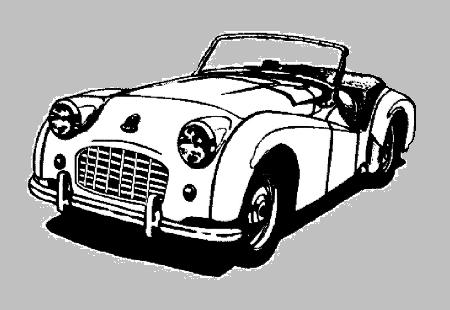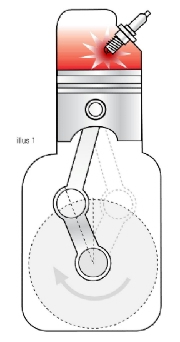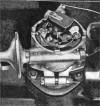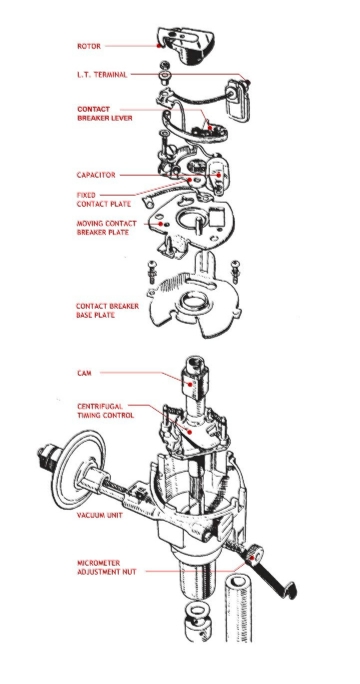
 Triumph Ignition Timing - Page 1
Triumph Ignition Timing - Page 1
|
Macy's Garage, Ltd. America's BEST Triumph Shop! |
This is an extensive look into the simple task of setting ignition timing on your Triumph TR2, TR3, or TR4. You may ask, “If it’s so simple, why does it require two web pages to explain?” The answer to that question is that on page one I will begin by explaining what timing is, why it’s important, and how the Triumph method is different from the way timing is “set” for most other makes. On the page two I will cover the actual timing procedure.
Without getting into the whole 4 stroke cycle of the internal combustion engines which power our Triumph sports cars, lets just jump right in and say that timing determines the exact instant that the spark plug will “fire” and light the compressed fuel and air mixture in each cylinder. This point is usually referred to as a certain number of degrees “before top dead center” (BTDC), a term which may require more explanation for some.
 Top Dead Center (TDC) is the point where the
piston has completed its rise to the top of the cylinder, and the fuel/air
mixture has been compressed as much as it can possibly be squeezed. Any further
rotation of the crankshaft will begin to pull the piston down and away from the
spark plug (and cylinder head). What we’d really like to see happen is that the
spark plug will fire at this exact moment, causing the fuel and air mixture to
burn and expand, driving the piston down to create the power we need and the
noise we love to hear. Note that I said that the fuel and air would burn and
expand, not explode, as many people believe. It happens very quickly, and if
you could see inside the cylinder it might resemble a small explosion, but it is
a controlled burn which takes a fraction of a second to complete, thus the need
to start the fuel burn a few degrees before the piston reaches the TDC
position. The degrees that we’re referring to are degrees of rotation of the
crankshaft, with 360 degrees being the total number of segments (degrees) that
define a circle (and you thought you’d NEVER have a use for that high school
Geometry!).
Top Dead Center (TDC) is the point where the
piston has completed its rise to the top of the cylinder, and the fuel/air
mixture has been compressed as much as it can possibly be squeezed. Any further
rotation of the crankshaft will begin to pull the piston down and away from the
spark plug (and cylinder head). What we’d really like to see happen is that the
spark plug will fire at this exact moment, causing the fuel and air mixture to
burn and expand, driving the piston down to create the power we need and the
noise we love to hear. Note that I said that the fuel and air would burn and
expand, not explode, as many people believe. It happens very quickly, and if
you could see inside the cylinder it might resemble a small explosion, but it is
a controlled burn which takes a fraction of a second to complete, thus the need
to start the fuel burn a few degrees before the piston reaches the TDC
position. The degrees that we’re referring to are degrees of rotation of the
crankshaft, with 360 degrees being the total number of segments (degrees) that
define a circle (and you thought you’d NEVER have a use for that high school
Geometry!).
Ideally the full burn should be completed when the piston has moved slightly downwards, or at about 20 degrees after top dead center (ATDC). The rate of burning for the fuel/air mixture takes a set amount of time, and the time required to complete this burn is fixed and does not change. For this reason, the timing is set so that the spark plug will fire a specific number of degrees before the piston reaches top dead center (BTDC) on the compression stroke, which allows the mixture to be completely burned at the correct point ATDC. As the engine speed increases, the timing must be “advanced” so that the spark plug will fire a greater number of degrees BTDC, allowing the fuel/air mixture the time necessary to be fully burned at the correct point for maximum power. When working correctly, the distributor will do this automatically as engine speed changes throughout normal driving. All we must do is set the starting point, the “initial timing”, and the distributor should do the rest.
 Our Triumph
TR2-4A distributors
are equipped with two separate systems for adjusting the ignition timing to meet
changing requirements due to various engine speeds and throttle positions.
First there are centrifugal weights inside the distributor which sense increased
engine speed, and mechanically advance the timing to larger and larger numbers
of degrees BTDC, giving the fuel/air mixture the time it needs to completely
burn by the correct point ATDC. This mechanical advance starts working between
450 and 700 RPM and will be fully advanced, adding an extra 22 degrees BTDC, by
2400 RPM. (These figures are for a Lucas 25D4 distributor in a TR4. Other
models are similar.) As engine speed slows down, the centrifugal weights don’t
spin as fast, and the timing “retards” back to a lesser number of degrees BTDC.
There’s also a vacuum advance chamber on the side of the distributor which can
add another 6-10 degrees of advance timing BTDC, depending on throttle position
and engine load.
Our Triumph
TR2-4A distributors
are equipped with two separate systems for adjusting the ignition timing to meet
changing requirements due to various engine speeds and throttle positions.
First there are centrifugal weights inside the distributor which sense increased
engine speed, and mechanically advance the timing to larger and larger numbers
of degrees BTDC, giving the fuel/air mixture the time it needs to completely
burn by the correct point ATDC. This mechanical advance starts working between
450 and 700 RPM and will be fully advanced, adding an extra 22 degrees BTDC, by
2400 RPM. (These figures are for a Lucas 25D4 distributor in a TR4. Other
models are similar.) As engine speed slows down, the centrifugal weights don’t
spin as fast, and the timing “retards” back to a lesser number of degrees BTDC.
There’s also a vacuum advance chamber on the side of the distributor which can
add another 6-10 degrees of advance timing BTDC, depending on throttle position
and engine load.
 Now after hearing all of
this, aren’t you glad that we only have to set the “initial” timing? The
automatic advance mechanisms of our Triumph distributors were a great
improvement over the earliest autos, which usually had a “spark” lever on the
steering column that required the driver to continually adjust the timing as
engine speeds changed. As good as we’ve got it, there have been many
improvements since our Triumphs first rolled off the assembly line. All of this
timing advance and retard stuff is now computer controlled on modern cars, and
non-wearing parts inside of today’s control boxes means that setting timing is
now a ritual reserved for those of us afflicted with “old car disease”.
Now after hearing all of
this, aren’t you glad that we only have to set the “initial” timing? The
automatic advance mechanisms of our Triumph distributors were a great
improvement over the earliest autos, which usually had a “spark” lever on the
steering column that required the driver to continually adjust the timing as
engine speeds changed. As good as we’ve got it, there have been many
improvements since our Triumphs first rolled off the assembly line. All of this
timing advance and retard stuff is now computer controlled on modern cars, and
non-wearing parts inside of today’s control boxes means that setting timing is
now a ritual reserved for those of us afflicted with “old car disease”.
In days past, when setting the timing of a car was a routine procedure, a strobe light affair called a timing light was normally attached to the number 1 spark plug and the timing was adjusted while the engine was running at idle. On most cars, this procedure produced the desired results because the idle speed was lower than the engine speed where the centrifugal weights would start to advance the timing. The Triumph owner however, will not achieve the desired results when setting the timing with a timing light.
If you recall from above, the mechanical advance can begin between 450 and 700 RPM. That’s pretty slow for a TR engine to idle, and without knowing exactly where it starts advancing, and by how much, we should probably use some other method to accurately set the initial timing. Fortunately, the engineers at Standard-Triumph specified a method for setting our initial timing with the engine OFF. This is nice in that it can be done in a cool engine compartment, and it keeps fingers and tools away from spinning fan belts and fan blades.
Now click on the link below to go to page 2, where I’ll go through the initial timing procedure, and touch on the electrical theory as to why it works.
Ignition Timing - Page 2











